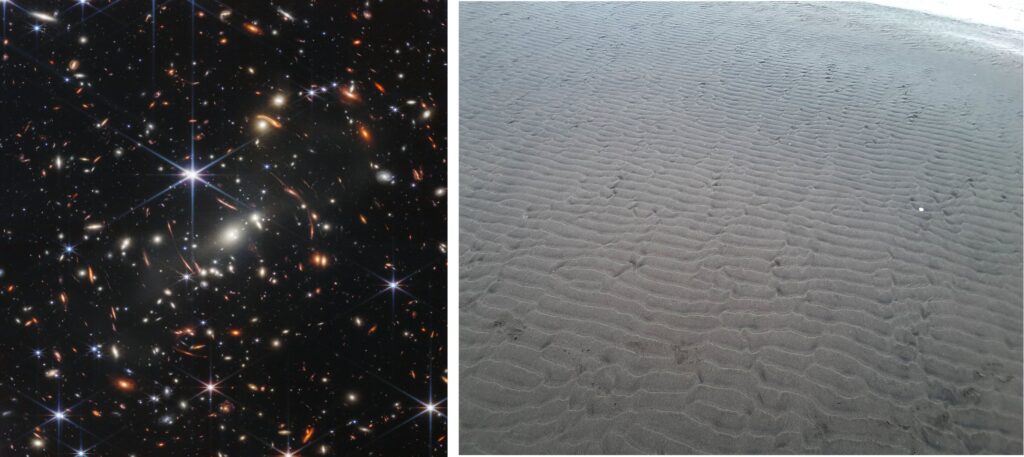
I wonder whether James R. Beerbower had any inkling that his paper on alluvial fan dynamics would seriously influence stratigraphic analyses and modeling some 60 years later? His 1964 paper focused on the development of stratigraphic cycles (as time units) and cyclothems (rock units), like those commonly found in alluvial and shallow marine strata. Beerbower’s analysis examined energy gradients, their influence on sediment distribution, the processes that cause active channels to shift from one part of the fan to another, and the potential for preservation of these events as cycles in the stratigraphic record. Beerbower (1964) defined two types of cycle based not on their physical rock form, but on the processes that influence their formation: the terms he borrowed, autogenic and allogenic, have become entrenched in geological literature.
auto – is from Greek autos meaning self or same; autogenic is from Greek autogenetos meaning self-born or self-producing. The word autogenic has been in use since the mid-19th C.; allo– is from Greek allos meaning other than or different
Autogenic processes are internal to the depositional system; there is no change in the total energy or sediment input although both are redistributed across the fan (e.g., Ventra and Clarke, 2018; OA). An oft-cited example of fluvial autogenesis is channel avulsion – channel aggradation (a process internal to all alluvial channels) proceeds to the point where there is a gravitational potential energy advantage for the channel to move to a lower gradient part of the fan. Local compaction of sediment may provide additional accommodation space for sediment accumulation.
However, Beerbower’s alluvial fan is also subjected to external processes and forces, such as regional subsidence, uplift of a hinterland, the occasional earthquake, variations in water supply and sediment routing, and eustatic changes in base level. Notably, alluvial fans are commonly associated with tectonically active highlands and sedimentary basin margins. In each case additional energy and material is forcibly added to or subtracted from the depositional system. Beerbower referred to these as allocyclic controls.
The intervening decades have seen a burgeoning interest and admission that much of the cyclicity we see in the rock record is generated by autocyclic processes (Budd and Hajek, 2016; Paola, 2016; Hajek and Straub, 2017). Much of this interest has been augmented by analogue and numerical models that have refined the boundary conditions that help us distinguish between autocyclicity and allocyclicity.
What is self-organization?
In Earth sciences and other disciplines, the term autogenic is commonly expressed in the same breath as the term self-organization. They are generally regarded as synonymous.
Self-organization is based on the recognition of patterns and the boundaries we place on them. We usually define patterns as the regular repetition or ordering of things. In systems that self-organize, these patterns are a spontaneous, emergent, and usually unexpected property of the system itself – they are not dependent on external forces, processes, or rules. Self-organizing patterns are recognized in many physical, chemical, and biological, social, and behavioural systems, at scales ranging from subatomic particles to the entire observable universe – a range of scales spanning 60 orders of magnitude (Aschwanden et al., 2018, OA).
Patterns can also arise in non-self-organizing systems, but the difference is fundamental. Patterns in non-self-organizing systems emerge from external influences, recipes, blueprints, or sets of instructions. In such cases, the resulting pattern is non-spontaneous and the pathway to create such patterns is deterministic.
Self-organization is defined in several ways although there is a common thread to each: Self-organization is a process in which pattern at the global level of a system emerges solely from numerous interactions among the lower-level components of the system (Sneyd et al., 2001).
Here, the term lower-level refers to components, processes, or actions internal to the system, without reference to global, or external inputs. The phrase numerous interactions dictates the internal components must operate in tandem rather than individually – they are interdependent. In this context interactions may augment, cancel, or modify one another.
This and most other definitions encapsulate three common properties of self-organizing systems (Favis-Mortlock, 2013, PDF). These properties can also be viewed as interdependent:
- Complexity
- Positive and negative feedback
- Emergence
Complexity
Numerous interactions among a system’s internal components implies complexity, in fact it has been stated that complexity is a necessary condition of self-organizing systems (Favis-Mortlock, op cit.). Definitions of complexity are quite vague, in part because the word can mean intuitively that a system of many parts cannot be fully understood. For example, consider the components and variables of an average river channel:
- The channel has variable gradients, dimensions, and 3D geometry.
- A range of sediment grain sizes, including some components that may act cohesively.
- Arrangements of bedforms and strata.
- Flowing water – laminar and turbulent, subcritical and supercritical flows.
- Channel margin flora and floodplain extent.
- Duration.
Each of these list entries can be subdivided multiple times. A sensible approach to the problem of complexity is taken by modellers who usually select a small number of system components or variables to examine experimentally or mathematically.
Feedback mechanisms
Most systems in our universe contain feedback mechanisms that influence whether a system works toward a return to some original state or degree of balance (negative feedback) or pushes the system towards a new state (positive feedback). Negative feedback mechanisms attempt to maintain stability in a system; positive feedback mechanisms tend to create system instability. In both cases the feedback mechanisms act internally.
The inclination of lee or avalanche faces on subaerial sand dunes tend towards a maximum value determined by internal system variables like wind speed, grain size, and moisture content – this value, or threshold is called the angle of repose. If wind speed increases such that the lee face oversteepens, sand will avalanche or flow down the face until the threshold angle is reestablished. These processes act as negative feedback mechanisms that re-establish the initial, more stable conditions.
The albedo effects of ice and clouds can have positive feedback effects on climate. If melting of expansive ice sheets occurs during atmospheric warming, there is a reduction in ice surface area and a consequent reduction in albedo; the overall effect is to further increase atmospheric temperatures. In this case, the positive feedback mechanism enhances the initial melting, potentially creating climate instability.
Emergence
Emergence refers to new structures that arise from internal interactions among the components of a system. An oft quoted example of self-organized emergence is the formation of ripples on a sand bed. Ripples form spontaneously when the velocity of air or water flow over a flat sand bed reaches a certain (threshold) value. The interacting variables here include fluid velocities that induce fluid drag forces, grain size and shape, and grain cohesiveness. The ripples are new structures that self-form in response to system instabilities; they have ordered structure and geometry (regular stoss and lee face geometry, internal stratification, and wavelengths). We can also think of this as a positive feedback response.
A few examples
Self-organization has been identified in almost every human endeavour. Self-organization in geomorphic and biological systems have obvious relevance to sedimentologic and stratigraphic systems. Self-organization in astronomical systems have a much broader reach in Earth science; I include this category because it illustrates the scope of thinking about the subject. At the other end of the scale is the self-organization of ice crystals.
Self-organization in geomorphic landscapes
Physical landscapes are the product of multiple interacting variables: the vagaries of weather and climate, chemical reactions, and biological processes including human activities that interact with bedrock, sediment, soil, and water. J.D. Phillips (1999,PDF) has identified 11 different definitions of self-organizing, or autogenic systems relating to geomorphic landscapes – a few examples are noted here:
- The internal processes that form landscapes tend towards a steady-state or equilibrium, for example the development of a river profile and the balance between sediment input and erosion. This definition is similar to Beerbower’s (1964) autocyclic condition where there is no energy gain or loss to the internal system, only energy transfers. The river channel profile is also influenced by allogenic processes such as hinterland uplift, erosional denudation, and base-level change but the actual response of the river system relies on processes within the channels themselves, such as stream flow, bedload and suspension load transport, bedforms, lateral channel migration, avulsion.
- Self-organization as a condition of system entropy; for example, a landscape that becomes increasingly dissected might be considered more disordered (increased relief) and hence increasing in entropy. In contrast, a river profile that reaches equilibrium tends toward lower entropy. Overall, there must be an increase in entropy to satisfy the Second Law of Thermodynamics.
- Self-organization as the tendency toward threshold states. A pile of dry sand will be stable where slopes are at the angle of repose, but if oversteepened sand will flow or avalanche until the threshold angle is regained. In some ways this is a restatement of the steady-state definition.
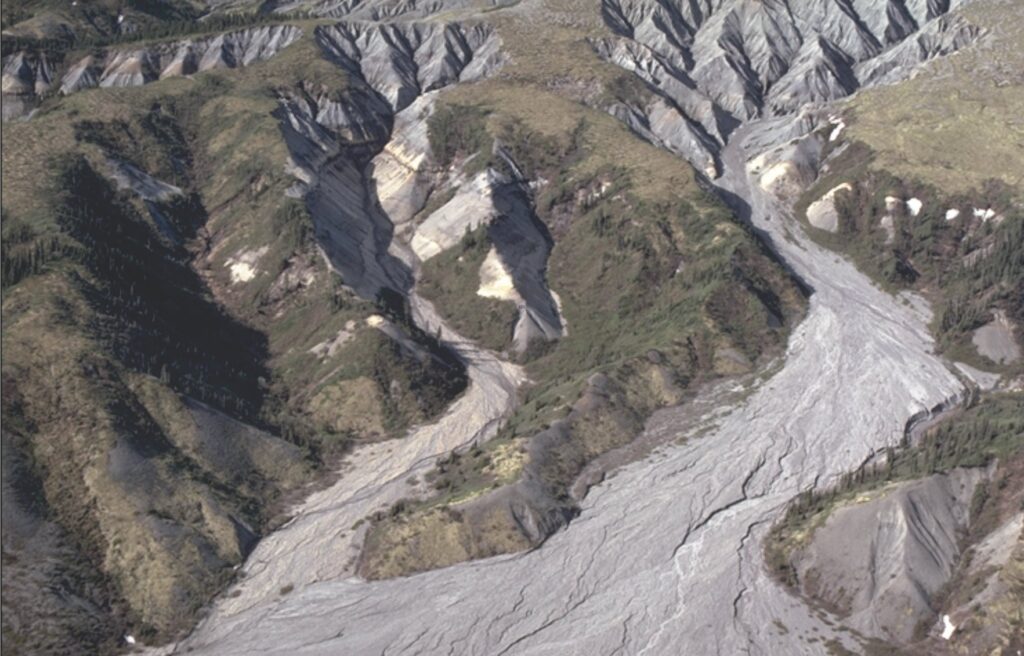
The foundations of landscapes arise from external forces that raise or lower large segments of Earth’s crust – most of these forces derive from far-reaching tectonic, climatic, and volcanic processes, and changes in base-level to produce grand vistas like mountains, plateaus, and large drainage basins. However, the development of smaller-scale geomorphic elements like river channels and bedforms, hillslopes, or soils depend on internal processes within each system. Importantly, autogenic landscapes can remain active even when external forcing is reshaping landforms (Scheingross et al., 2020). Under these circumstances, teasing apart the effects of self-organization and the products of allogenic processes becomes increasingly difficult.
Self-organization in biological systems
Biological self-organization has been recognized in many living organism systems. Iconic examples include:
- The schooling of fish and murmurations of birds, where there is an advantage for individuals to take note of what their neighbours are doing.
- The colourful patterns on sea shells.
- The architecture of termite mounds.
The concept has also been extended to whole ecosystems. A fine review of ecosystem self-organizing systems and the problems associated with their recognition in the rock record is given by Tom Olszewski (2016).
One of the earliest applications of self-organization to ecosystems is the concept of species succession. A frequently cited example relates the observed succession of plants on initially barren land. In the classic model, pioneer species that take advantage of the available space and nutrients, subsequently enhance soil development such that larger species (e.g., shrubs, small trees) gradually compete for the available space, nutrients, and sunlight (increased plant canopy is an internal feedback mechanism that limits the availability of light to the pioneer plants). In this model large, slower growing trees with more extensive canopies and root systems are the climax addition to this succession. Taken literally, this model of succession is deterministic and is now considered too simplistic. In its place, are several alternative explanations for ecological successions like this, such as the tolerance for changing nutrient availability suits some species more than other, or the inhibition model where so-called climax species could be established during the initial growth stages but because they are slower growing are inhibited from doing so (Olszewski, op. cit.). The main point in all three models is that species succession in extant ecosystems is not entirely random – that there are patterns, and aspects of these patterns are autogenic, or self-organized.
Ecological studies of extant and ancient biological systems have demonstrated that species not only exist within a sedimentary environment (of any kind) but can modify their environment – good examples include bioturbation, changes in sediment texture such as accumulations of fecal pellets, bioeroded fine sediment, or the production of mud as is the case with aragonite-producing algae like Halimeda. Environmental modification by a particular species that also affects the ecology and behaviour of other organisms is referred to as ecological engineering (e.g., Olszewski, op. cit.). Most of these activities are internal, or autogenic and can result in species succession in the event of niche competition, predation, or simply not liking your neighbours. One might expect that the stratigraphic record is replete with paleoecological successions that reflect these kinds of changes, and indeed many such successions have been identified.
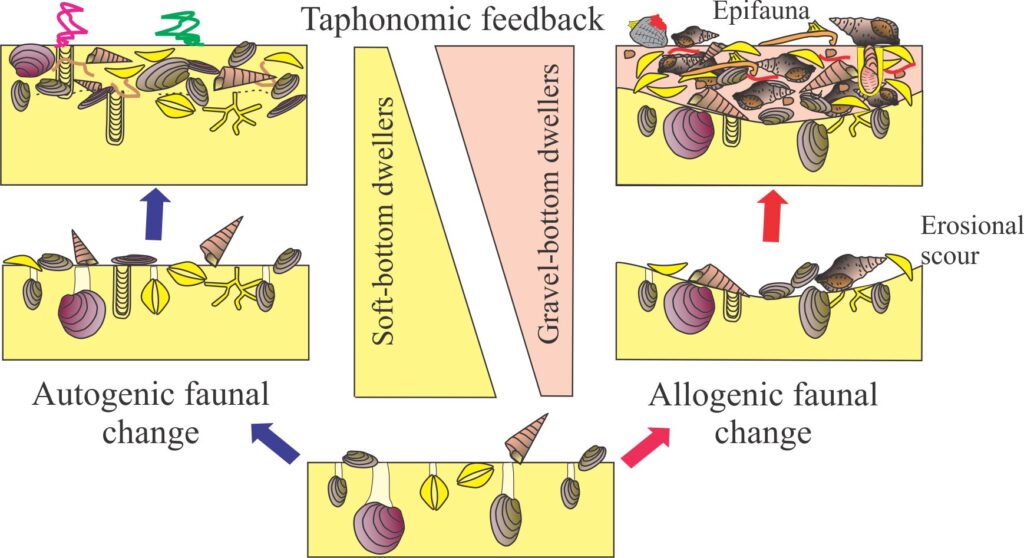
However, the process of recognizing ecological succession in the rock record is fraught because stratigraphic units, by their very nature, represent a kind of time-averaged record of events – averaged over the rock units present and those that are missing. Even the most basic stratigraphic unit, a bedding plane, presents us with a fundamental problem – does this plane represent autogenic or allogenic process, the record of which no longer exists? A bedding plane that represents inactive sedimentation over part of an alluvial fan is likely an autogenic response to autogenic channel avulsion. Equally, it could signal allogenic forcing of base-level change. And herein lies a fundamental dilemma that is foisted on our interpretations of self-organization in any geological system – can we confidently exclude allogenic processes from the autogenic equation?
Self-organization at the microscopic scale
The example I have chosen in this category, Ostwald ripening, has been suggested as a possible mechanism for the precipitation of neomorphic calcite spar that is commonly observed in carbonate cements and replacement fabrics. Neomorphism is basically a kind of recrystallization, but in this case, it involves a mineral replacing itself (e.g., calcite to calcite). The process commonly produces crystals much larger than the original form (aggrading neomorphism). The analogy used is that of Ostwald Ripening first observed in deformed metals, where small crystals or grains grow, or recrystallize into larger crystals (there is a thermodynamic advantage to this) (after Wilhelm Ostwald in 1896). The process also has a familiar, but annoying outcome in substances like ice-cream. If ice-cream is warmed slightly then refrozen, the original small ice crystals (that create a smooth creamy texture) recrystallize to larger crystals that give it a course, less pleasant texture. Ostwald ripening is regarded as a self-forming or self-organizing process because it is spontaneous, non-random, and requires no additional chemical input.
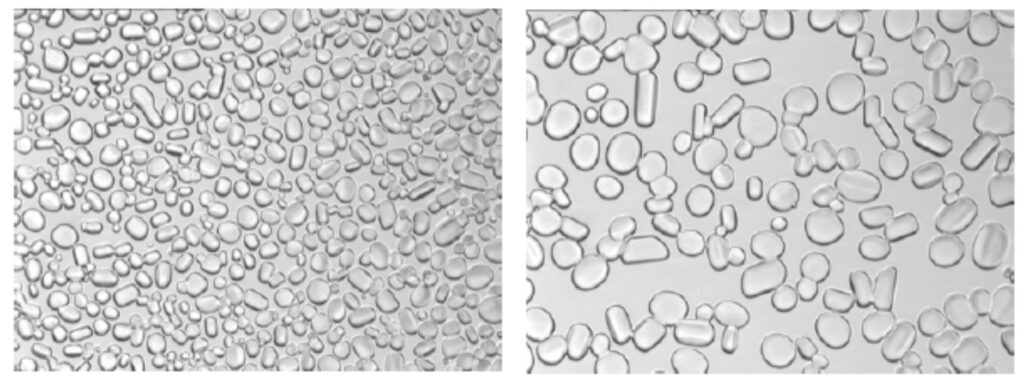
Self-organization in astronomical systems
Self-organization has been hypothesized in astronomical systems ranging from a planet’s rings and moons to solar systems, planetary discs that give rise to all manner of planetary bodies, and entire galaxies. Cosmological self-organization has also been hypothesized for the complete observable universe. An excellent (although fairly technical) review of these theoretical considerations is given in Aschwanden et al., 2018.
Planetary spacing and Saturn’s rings
Planetary spacing in our solar system, and probably most exoplanet systems, is non-random. This was discovered more than 250 years ago and is expressed in the Titius-Bode Law. The law generally describes the spacing of planets as a function of orbital resonances; the fundamental controls are gravity counterbalanced by centrifugal forces. In this case the centrifugal forces are considered a feedback mechanism that prevents planets from falling into the sun. Other feedbacks involve the gravitational effects of adjacent planets that play a role in generating elliptical rather than circular orbits. Arguably, development of stable orbits is a product of self-organization.
Similar arguments have been applied to planetary moons and rings (Saturn, Jupiter, Uranus, Neptune). The organization of rings, particularly the gaps between ring groups is also hypothesized to be a function of harmonic resonances, where the primary dynamic drivers are gravitational forces and particle collisions.
Protoplanetary discs
Planetary discs consisting of ionized gas are common around young stellar systems; some wonderful images of far-off discs have been taken by the Hubble, James Webb, and ALMA telescopes. Protoplanetary discs are the progenitors of planets, asteroids, and comets; our own solar system probably began as a planetary disc around the newly formed sun. The star itself forms by internally generated gravitational collapse of interstellar gas particles that initially are randomly distributed. The remaining particles develop angular momentum that prevents them from collapsing into the young star. Protoplanetary discs represent self-organization into the most stable flat-disc geometry that minimizes the gravitational potential energy. Accretion of planets and planetesimals within a disc also takes place via internally generated collisions and gravitational attraction.
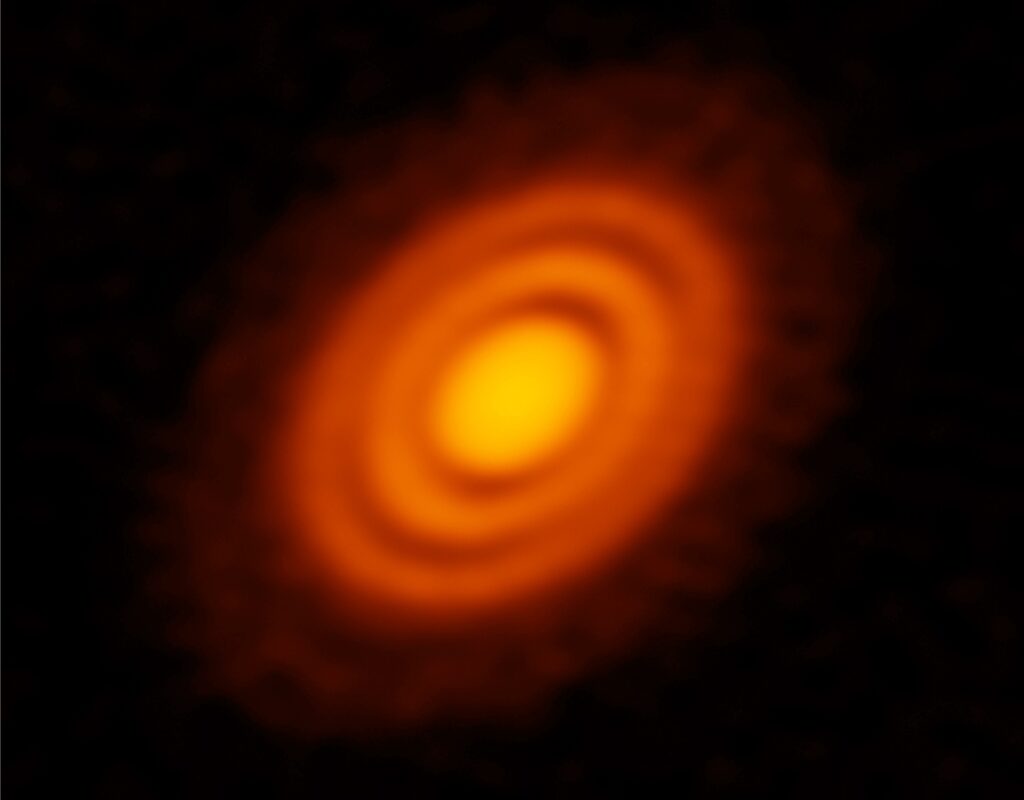
Distinguishing self-organizing from allogenic systems; a few questions – and even fewer answers
Given the stricture of the usual definitions of self-organization one could develop the impression that distinguishing between autogenic and allogenic processes should be fairly straight forward. It is not. The discussion below uses alluvial fans as an example, but the comments apply to any depositional system.
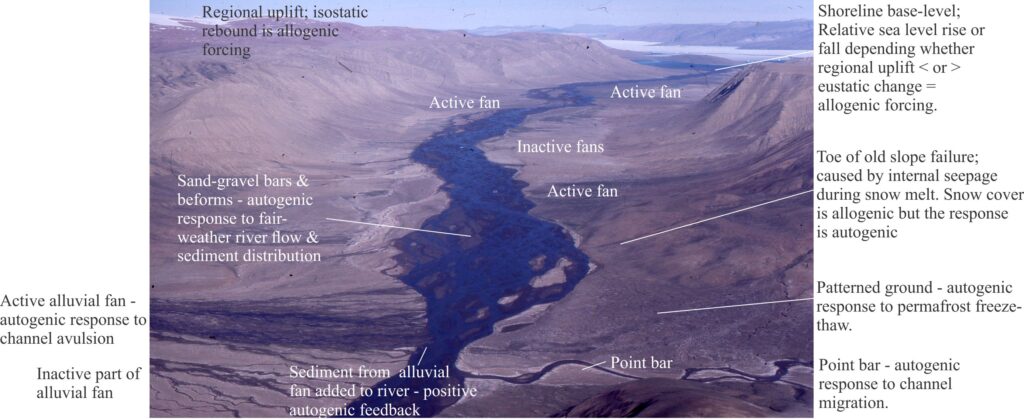
Returning to the example of modern alluvial fans – if we witness the changes in sediment distribution and aggradation resulting from channel avulsion under normal conditions then we can promote the cause of autogenesis and the potential formation of an autocycle with confidence. However, channel avulsion can also occur during storms where there is a significant increase in water flow and introduction of new sediment, both of which are defined as allocyclic additions to the system. How do we tell the difference?
A sedimentological indicator might include an erosion surface and partial removal of an earlier-formed cycle. But erosion is an expected consequence of channel avulsion under both autogenic and allogenic circumstances. We might be more confident in promoting allogenic causes if there was a significant increase in clast size associated with the erosion surface that would indicate an increase in flow energy for that event; particularly if the unit could be mapped over the fan extent. Otherwise, the distinction between the two is tricky.
All sedimentation and stratigraphic successions depend on accommodation space. Repeated autogenic channel avulsion and cyclothem development across an alluvial fan is limited to the accommodation space available at that time. The only way to increase the space to accommodate new cycles is for either periodic or continuous subsidence of the fan, uplift of the adjacent hinterland, changes in base-level associated with eustasy, or combinations of all three mechanisms. We usually regard each of these mechanisms as allogenic. The distinction between continuing allogenic mechanisms that forcefully produce accommodation space, and the space created by autogenic mechanisms is a problem that stratigraphers and modelers still grapple with.
And then there’s the question of scale, one of the central questions posed in a review by Hajek and Straub (2017). How large, extensive, or regional can autogenic systems be? If the astrophysicists are correct and entire galaxies are self-forming, then one might be forgiven in thinking that virtually everything on Earth, a mote of dust within our own galaxy, is self- organized and we no longer need to continue the discussion. If that were true, we’d all be out of a job so let’s persist by recognizing that alluvial fans usually reside within much larger drainage basins. Recent modeling suggests that whole-basin drainage networks and their associated landscapes are self-organized; for example, treating drainage patterns as fractals (Rodriguez-Iturbe et al., 1994), or by considering bedload sediment output derived from evolution of drainage basins (De Weil and Coulthard, 2010). Self-organization of river channels into tree-like or dendritic networks is likely across entire drainage basins. In other words, both the drainage networks and the sediment dynamics within them emerge spontaneously from internal, autogenic processes.
Modeling has also shown that changes in sediment dynamics in one part of a drainage basin can affect depositional systems in other parts of the basin – Coulthard and De Weil (2017) refer to this as sediment, or geomorphic connectivity.
This poses an interesting question: if a geomorphic event (e.g., local slope failure) occurring in one part of a basin causes a response on an alluvial fan elsewhere within the same basin, is that response allogenic or autogenic? The cause is external to the fan, but it is also an integral part of the larger self-organizing drainage system to which the fan belongs. One answer might be that the question is not useful. Another might frame the answer in terms of the boundary conditions we place on our investigations – if we examine the fan in isolation (perhaps because of limited preservation) then we might infer allogenic forcing, or we could say we can’t tell the difference. But if we frame the investigation in terms of the entire basin then we might reasonably infer autogenic forcing.
Which begs a supplementary and final (unanswered) question – does the distinction between self-organized/autogenic and allogenic forcing depend foremost on our frame of reference and the arbitrary boundary conditions we place on systems?

















